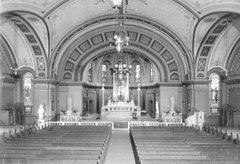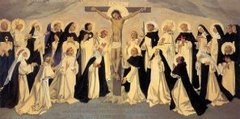As Church fixes abuse problem, society must follow suit
By Bishop Robert Vasa
April is National Child Abuse Prevention Month. During this month there has been an increased level of activity and concern expressed about the extent of child abuse in our country and in the world as a whole.
There has been a bright light shining on the flaws and faults of the Church in regard to its past and even present failures in regard to reporting child abuse and protecting children from abuse. This light is not at all comfortable but it is necessary and hopefully it is also purifying. Unfortunately the focus of the past and even into the present is that all too human tendency to deny, minimize and even fail to recognize the presence of abuse. There is also a definite need to be more vigilant about who is allowed into the priesthood and who is allowed to have access to children.
The bright light shining on the Church, however, may be shading other areas of society where abuse is much more prevalent and much less noticed. The 2009 Report by the Secretariat of Child and Youth Protection of the United States Conference of Catholic Bishops indicates that during the course of 2009 there were nearly 400 new allegations of abuse presented to dioceses in the United States. This number is indeed distressing but it does need to be looked at a bit more carefully. There were 352 allegations presented to dioceses that occurred prior to 1990. More than one-third of these instances of abuse (127) occurred as long as 40 or 60 years ago. This does not diminish the gravity of the abuse but it is very difficult for most priests and bishops of today to claim responsibility for abuse that occurred so long ago. To say that the “church” allowed this abuse to happen is to fail to recognize that priests and bishops in the Church from 40 to 60 years ago failed to do all that they should have done to prevent and report such abuse. The same can be said of those very tragic years between 1970 and 1990 when a vast majority of the abuse occurred. Of the new allegations received in 2009, 225 were from these years. This number may be slightly higher if one adds in the 14 cases presented without specification of a particular year. This would raise the number for these years to 239.
The report, while acknowledging the serious shortcomings of Church leadership in the past, as indicated by the number of allegations still coming forward from those years, has some hint of hopeful news. During the course of 2009 there were 24 cases presented to dioceses that involved abuse occurring since 1990. Thus, from this 20-year period, 24 persons who had been abused came forward in 2009. Considering that there are approximately 195 dioceses and eparchies in the United States this would mean that in 2009 a vast majority of dioceses have not received a claim of having been abused during these years. This does not mean that there are no other victims still struggling with the trauma of having been abused during these years but hopefully this relatively low number can be seen as a sign of hope.
A further and very real sign of hope is the report’s counting of the number of new allegations received in 2009 for abuse that occurred last year. This number is 6. If this is at all accurate it would show that the Church has indeed taken the horrible trauma and scandal of child sexual abuse very seriously and that the efforts of the Church, its bishops, priests and laity, are bearing fruit. We do not deny the past but the efforts of the Church these past 10 to 20 years seem to be having a positive effect. I pray it is so. It is indeed most sad that the Church did not take these strong measures 40 years ago and for that we apologize to the people of God and most especially to those who have been harmed and often grievously harmed because evil and sinful priests were allowed to continue in ministry after their evil inclinations and actions were manifested and known by those who had the power and the duty to remove them.
In great contrast to this sign of hope in the Church I need only refer to the state of Oregon. According to an April 22 headline: “Change needed in abuse investigations.” In brief, the story points out that in 2009, Oregon state workers screened 67,885 reports of child abuse and neglect. These 67,000 reports generated 28,584 investigations. These 28,000 investigations revealed 11,090 children who were victims of abuse or neglect. The story points out that nearly half of these children were under 6.
This is an area that needs the same bright and unrelenting light of truth that has been focused so diligently on the Church these past 20 years. I do not at all defend the past negligence of the Church but I do commend her increasing vigilance these past 20 years. Where is the vigilance in our society? How can nearly 5,000 pre-kindergarten children be the victims of some form of abuse or neglect in Oregon in a single year? If we conservatively multiply this number (which would undoubtedly be much larger in many states) by a mere factor of 40 we come to the most shameful possibility that more than 200,000 pre-school age children in the United States may have suffered some form of abuse or neglect in 2009. Yet, the story will receive one day of coverage in the local paper and then pass again into oblivion until April of next year. In the meantime, every single report involving the Church will make national news for days and sometimes weeks. One could begin to wonder if the public concern is really about the welfare of children at all.
I want to commend and encourage The Central Oregon KIDS Center and their promotion of Darkness to Light Training. KIDS Center, among other things, provides education and consultation to community members and professionals throughout Central and Eastern Oregon on issues related to child abuse and neglect. In a recent news article one of the Darkness to Light Trainers noted: “There is only one person responsible for children, and that is every single adult.”
This type of training and attitude, too, is a great sign of hope.
© 2010, Catholic Sentinel
Do the math. where's the outrage?



























